Mine-Microseismic-Signal Recognition Based on LMD–PNN Method
Abstract
:1. Introduction
2. Basic Theory
2.1. Local Mean Decomposition (LMD)
2.2. Energy Entropy
2.3. Probabilistic Neural Network (PNN)
3. LMD–PNN Microseismic-Signal Recognition
3.1. Feature Extraction
3.2. Automatic Recognition Process of Microseismic Signal
- (1)
- The vibration signal of the mine site is collected by microseismic equipment, and the collected signal is preprocessed to filter out the noise signal and obtain the mine microseismic signal.
- (2)
- The LMD algorithm is compiled to calculate the mine microseismic signal, and all PF components and residual uk(t) are obtained by signal decomposition.
- (3)
- Since the extraction of all PF components of the original microseismic signal is likely to cause vector redundancy, which is not conducive to effective classification, the correlation analysis coefficient (Equation (7)) is used to screen the effective PF components.
- (4)
- First, the energy value of the PF component decomposed by the microseismic signal is obtained by Equation (3). Then, the energy value is normalized and substituted into Equation (4). Finally, the LMD-energy-entropy value of the microseismic signal is obtained by Equation (5), and the eigenvector values of all types of mine microseismic signals are obtained.
- (5)
- The PF component entropy with the correlation coefficient greater than 0.3 is taken as the eigenvector value of the mine-microseismic-signal type, and the eigenvector of the PNN mine-microseismic-signal-classification model is constructed.
- (6)
- The random method is used to automatically select the training and prediction samples, the optimal model parameters are automatically obtained by the learning and training system of the samples, and the PNN classification model is established.
- (7)
- Finally, using the established PNN model, the unknown microseismic samples are judged and classified.
4. Simulation-Signal Test
5. Engineering Case Analysis
5.1. Microseismic-Signal-Waveform Analysis
5.2. Feature Extraction
5.3. PNN Classification and Identification
6. Conclusions
- (1)
- There are regularities in the energy-entropy value of the PF component of the measured field microseismic signal. The rupture signals of coal-and-rock masses are mainly concentrated below 100 Hz, and the energy-entropy values of PF3~PF4 are mostly slightly larger than that of PF1~PF2, while the blasting-vibration signals are mainly concentrated above 100 Hz, which is exactly the opposite of the law of coal-and-rock-mass-rupture signals. The mine-microseismic-signal characteristics constructed by LMD and energy entropy can well characterize the time-frequency law of coal-and-rock-mass-rupture signals and blasting-vibration signals, and can effectively express the change characteristics of mine microseismic signals.
- (2)
- The PNN mine-microseismic-signal-identification method proposed in this paper shows a greater identification advantage compared to the BPNN and GRNN methods in terms of prediction accuracy and calculation time. Therefore, the LMD–PNN model is a new effective method for identifying microseismic signals in mines.
Author Contributions
Funding
Informed Consent Statement
Data Availability Statement
Acknowledgments
Conflicts of Interest
References
- Yuan, L. Research progress on risk identification, assessment, monitoring and early warning technologies of typical dynamic hazards in coal mines. J. China Coal Soc. 2020, 45, 1557–1566. [Google Scholar]
- Zhang, C.; Jin, G.H.; Liu, C.; Li, S.G.; Xue, J.H.; Cheng, R.H.; Wang, X.H.; Zeng, X.Z. Prediction of rockbursts in a typical island working face of a coal mine through microseismic monitoring technology. Tunn. Undergr. Space Technol. Inc. Trenchless Technol. Res. 2021, 113, 103972. [Google Scholar] [CrossRef]
- Cao, W.Z.; Durucan, S.; Cai, W.; Shi, J.Q.; Korre, A. A physics-based probabilistic forecasting methodology for hazardous microseismicity associated with longwall coal mining. Int. J. Coal Geol. 2020, 232, 103627. [Google Scholar] [CrossRef]
- Ma, C.C.; Li, T.B.; Zhang, H.; Wang, J.F. An evaluation and early warning method for rockburst based on EMS microseismic source parameters. Rock Soil Mech. 2018, 39, 765–774. [Google Scholar]
- Lin, B.I.; Wei, X.I.E.; Zhao, J.J.; Zhao, H. Automatic classification of multi-channel microseismic waveform based on DCNN-SPP. J. Appl. Geophys. 2018, 159, 446–452. [Google Scholar] [CrossRef]
- Duan, Y.; Shen, Y.R.; Canbulat, I.; Luo, X.; Si, G.Y. Classification of clustered microseismic events in a coal mine using machine learning. J. Rock Mech. Geotech. Eng. 2021, 13, 1256–1273. [Google Scholar] [CrossRef]
- Wilkins, A.H.; Strange, A.; Duan, Y.; Luo, X. Identifying microseismic events in a mining scenario using a convolutional neural network. Comput. Geosci. 2020, 137, 104418. [Google Scholar] [CrossRef]
- Cheng, T.D.; Yi, Q.W.; Wu, Y.W.; Dai, C.C.; Cai, G.P.; Yang, L.R.; Yin, B.Y. Application of improved EWT_MPE model in feature extraction of mine micro-seismic signals. J. Vib. Shock. 2021, 40, 92–101. [Google Scholar]
- Jiang, R.C.; Dai, F.; Liu, Y.; Wei, M.D. An automatic classification method for microseismic events and blasts during rock excavation of underground caverns. Tunn. Undergr. Space Technol. 2020, 101, 103425. [Google Scholar] [CrossRef]
- Zhang, J.Y.; Jiang, R.C.; Li, B.; Xu, N.W. An automatic recognition method of microseismic signals based on EEMD-SVD and ELM. Comput. Geosci. 2019, 133, 104318. [Google Scholar] [CrossRef]
- Chen, Z.; Ding, L.L.; Luo, H.; Song, B.Y.; Zhang, M.; Pan, Y.S. Mine microseismic events classification based on improved wavelet decomposition and ELM. J. China Coal Soc. 2020, 45, 637–648. [Google Scholar]
- Zhao, G.Y.; Deng, Q.L.; Li, X.B.; Dong, L.J.; Chen, G.H.; Zhang, C.X. Recognition of microseismic waveforms based on EMD and morphological fractal dimension. J. Cent. South Univ. (Sci. Technol.) 2017, 48, 162–167. [Google Scholar]
- Zhao, G.Y.; Ma, J.; Dong, L.J.; Li, X.B.; Chen, G.H.; Zhang, C.X. Classification of mine blasts and microseismic events using starting-up features in seismograms. Trans. Nonferrous Met. Soc. China 2015, 25, 3410–3420. [Google Scholar] [CrossRef]
- Vallejos, J.A.; McKinnon, S.D. Logistic regression and neural network classification of seismic records. Int. J. Rock Mech. Min. Sci. 2013, 62, 86–95. [Google Scholar] [CrossRef]
- Pu, Y.Y.; Apel, D.B.; Hall, R. Using machine learning approach for microseismic events recognition in underground excavations: Comparison of ten frequently-used models. Eng. Geol. 2020, 268, 105519. [Google Scholar] [CrossRef]
- Dong, L.J.; Sun, D.Y.; Li, X.B.; Ma, J.; Chen, G.H.; Zhang, C.X. A statistical method to identify blasts and microseismic events and its engineering application. Chin. J. Rock Mech. Eng. 2016, 35, 1423–1433. [Google Scholar]
- Dong, L.L.; Jiang, R.C.; Xu, N.W.; Qian, B. Research on Microseismic Signal Denoising Method Based on LMD-SVD. Adv. Eng. Sci. 2019, 51, 126–136. [Google Scholar]
- Liu, Z.L.; Jin, Y.Q.; Zuo, M.J.; Feng, Z.P. Time-frequency representation based on robust local mean decomposition for multicomponent AM-FM signal analysis. Mech. Syst. Signal Process. 2016, 95, 468–487. [Google Scholar] [CrossRef]
- Zhang, X.B.; Liu, C.; Liu, Y.; Wang, D.; Gou, F.Y. Seismic data time frequency decomposition based on local mean decomposition. J. Jilin Univ. (Earth Sci. Ed.) 2017, 47, 1562–1571. [Google Scholar]
- Lu, T.; Yu, F.Q.H.; Wang, J.R.; Wang, X.Y.; Mudugamuwa, A.; Wang, Y.F.; Han, B.K. Application of adaptive complementary ensemble local mean decomposition in underwater acoustic signal processing. Appl. Acoust. 2021, 178, 107966. [Google Scholar] [CrossRef]
- Zhao, H.Y.; Wang, J.D.; Lee, J.; Ying, L. A compound interpolation envelope local mean decomposition and its application for fault diagnosis of reciprocating compressors. Mech. Syst. Signal Process. 2018, 110, 273–295. [Google Scholar]
- Smith, J.S. The local mean decomposition and its application to EEG perception data. J. R. Soc. Interface 2005, 2, 443–454. [Google Scholar] [CrossRef] [PubMed]
- Sun, C.Y.; Hu, Y.; Shi, P. Probabilistic neural network based seabed sediment recognition method for side-scan sonar imagery. Sediment. Geol. 2020, 410, 105792. [Google Scholar] [CrossRef]
- Chaki, S.; Routray, A.; Mohanty, W.K. A probabilistic neural network (PNN) based framework for lithology classification using seismic attributes. J. Appl. Geophys. 2022, 199, 104578. [Google Scholar] [CrossRef]
- Sun, Y.; Yang, F.; Zheng, J.; Zhang, H.; Xu, M.X. Research on microseismic signal denoising based on variational mode decomposition and wavelet energy entropy. J. Min. Sci. Technol. 2019, 4, 469–479. [Google Scholar]
- Specht, D.F. Probabilistic neural networks. Neural Netw. 1990, 33, 109–118. [Google Scholar] [CrossRef]
- Xu, F.; Liu, Y.F. Feature extraction and classification method of acoustic emission signal based on EMD-SVD. J. Basic Sci. Eng. 2014, 22, 1238–1247. [Google Scholar]
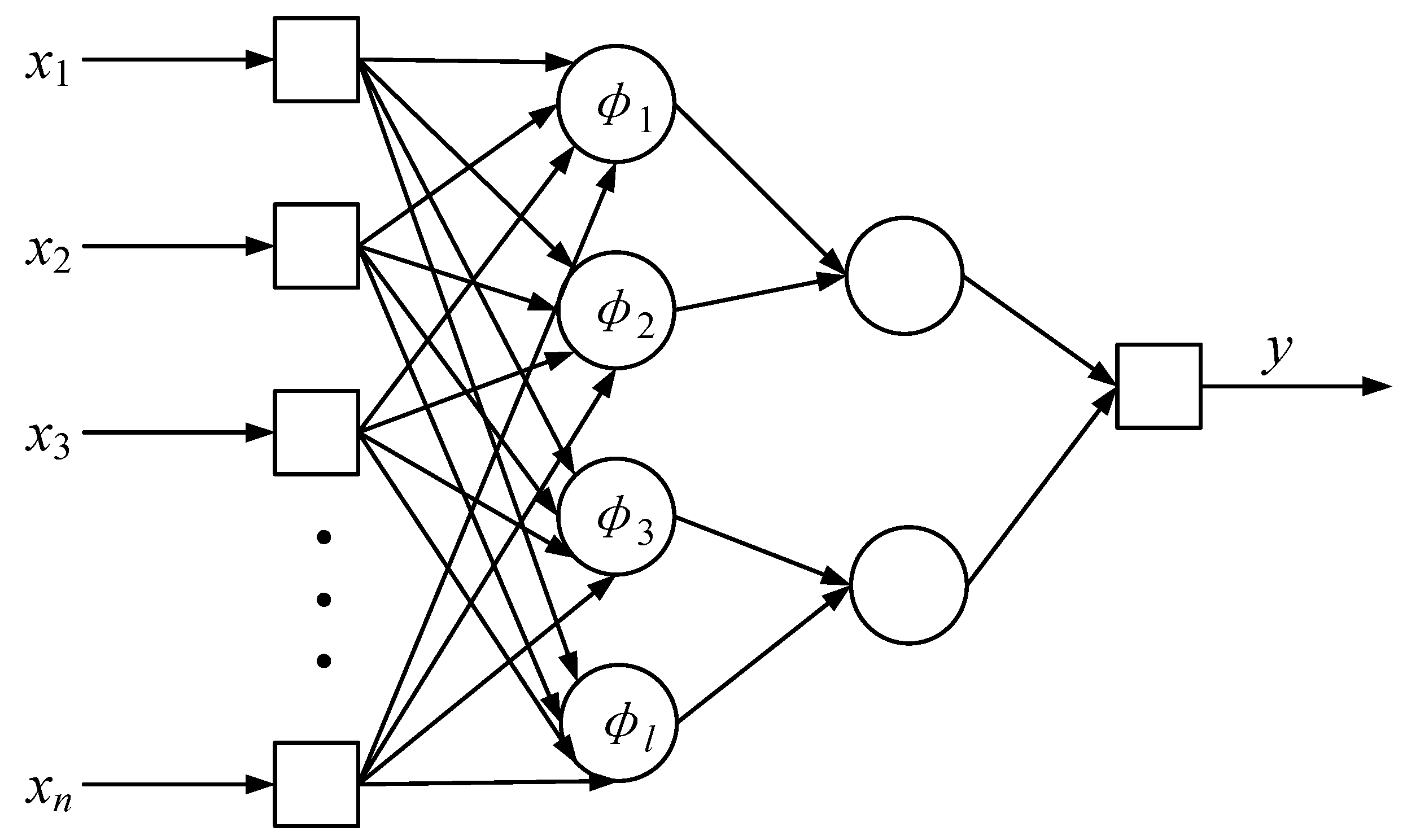

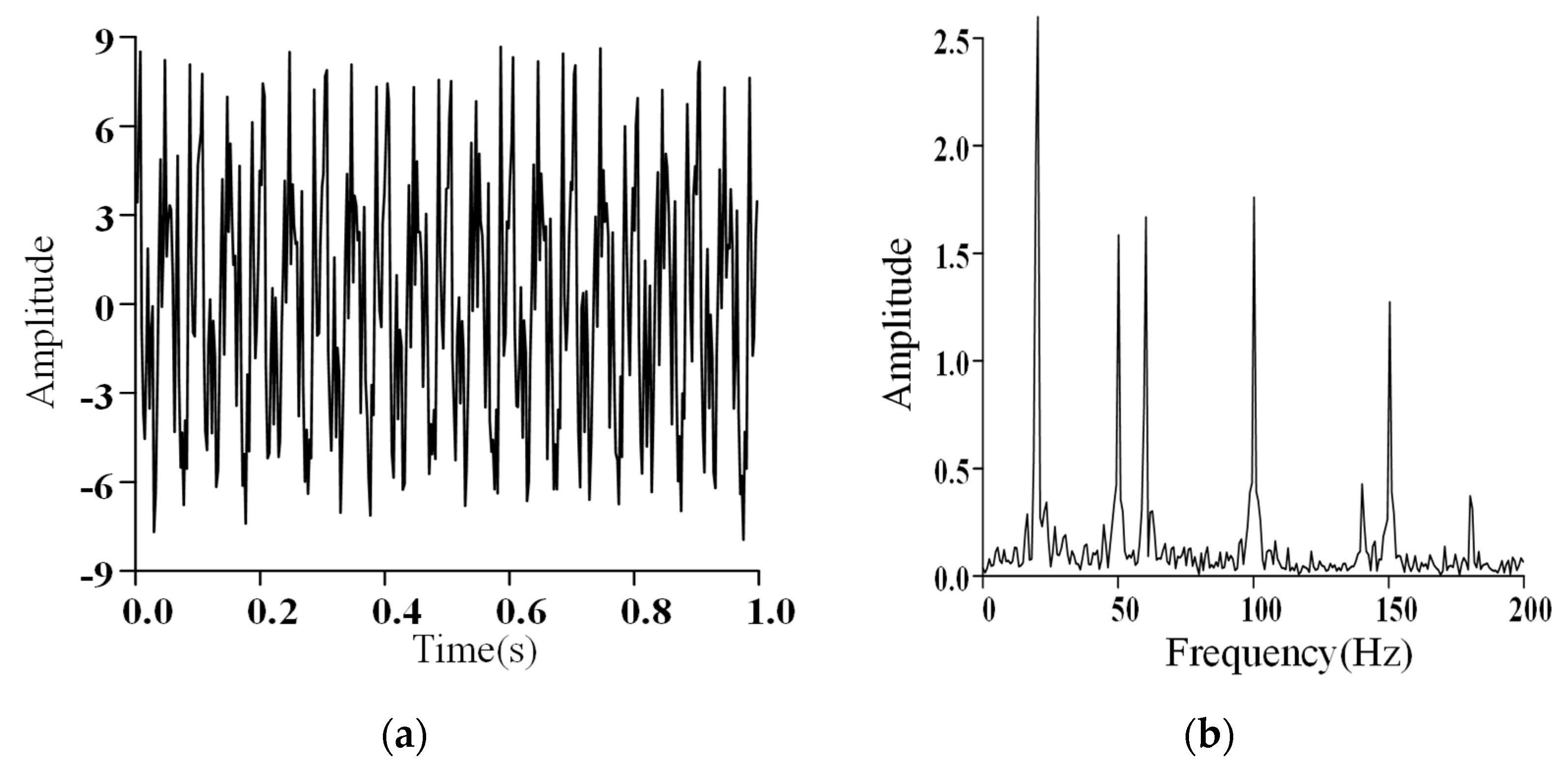
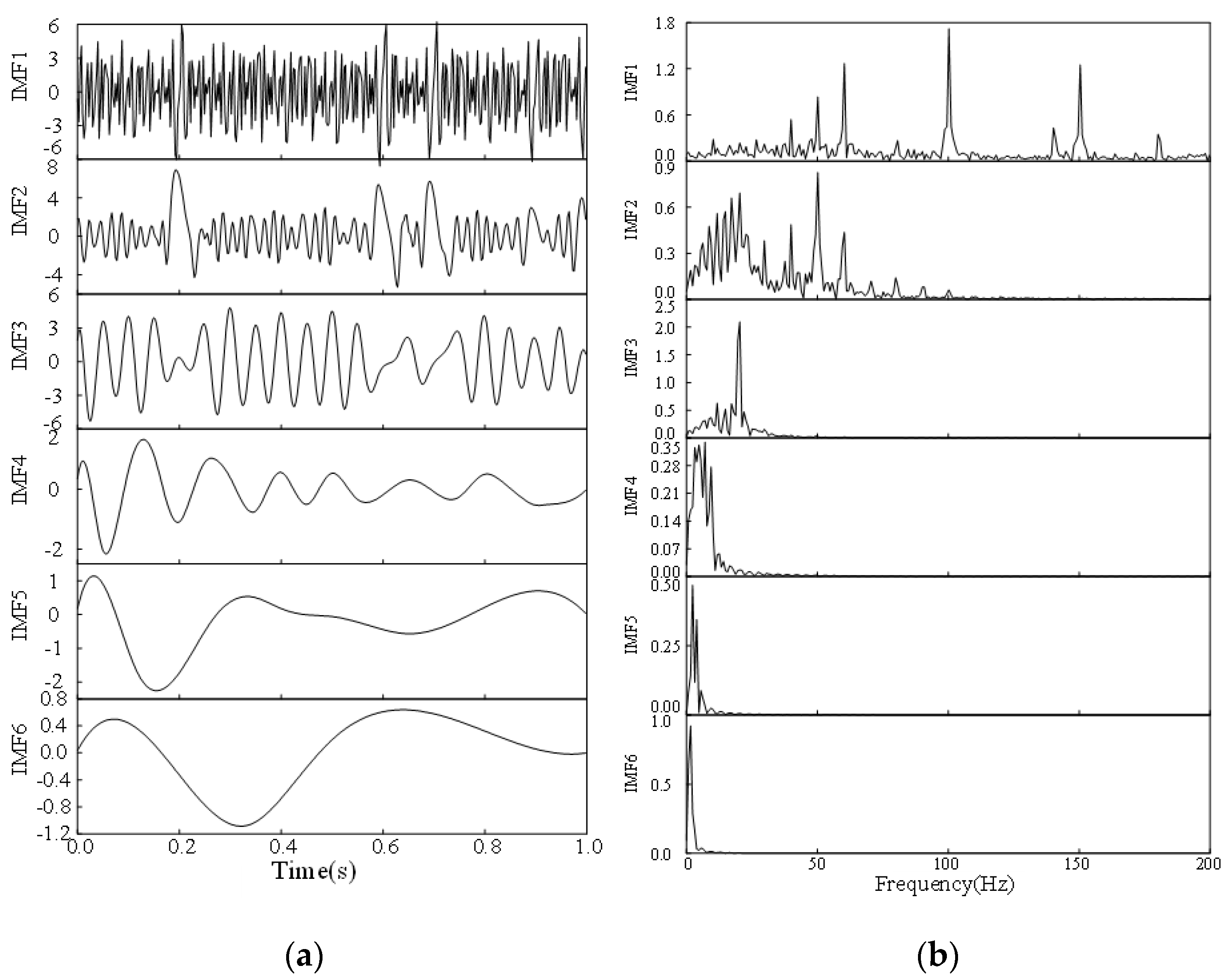
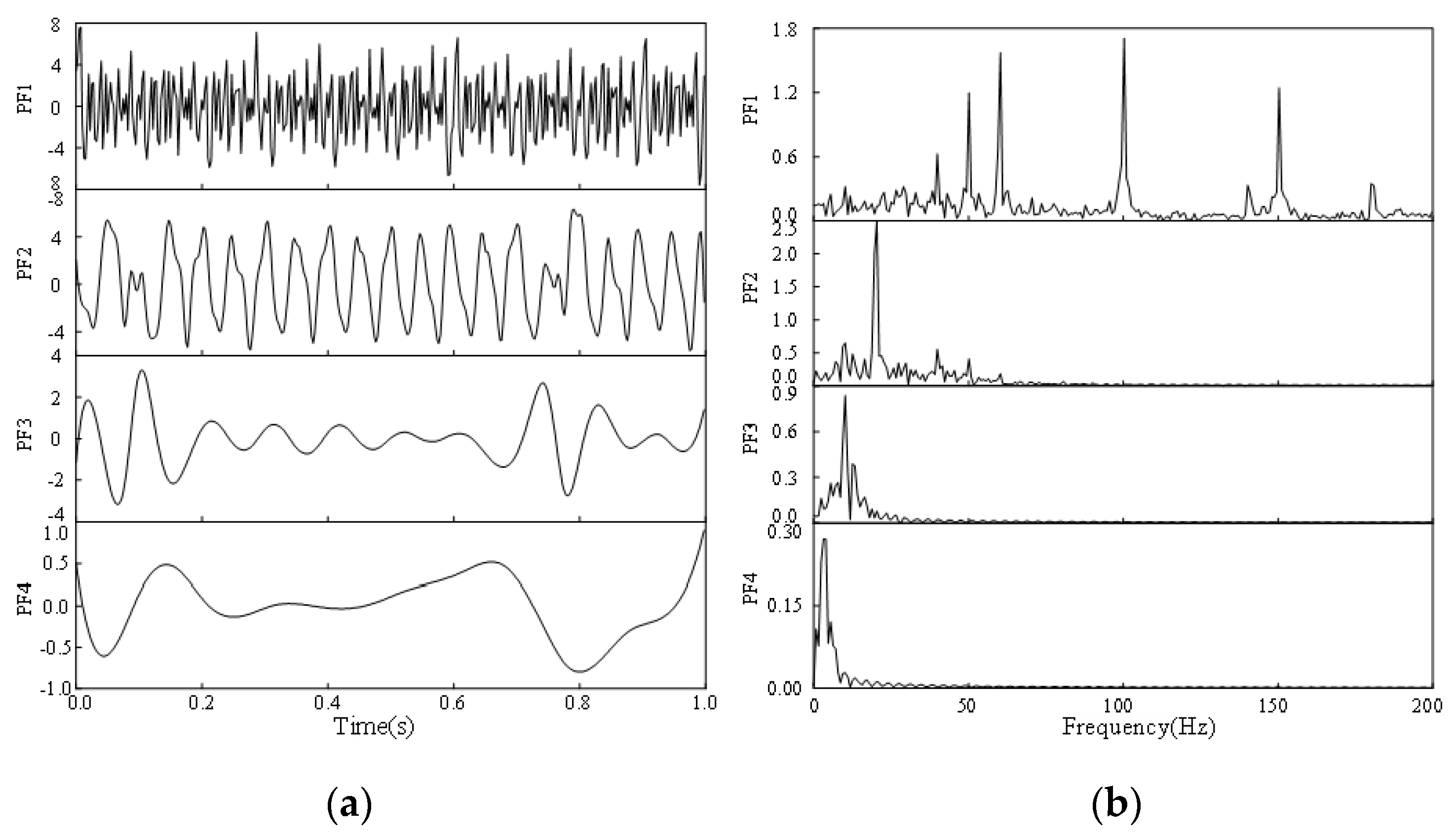
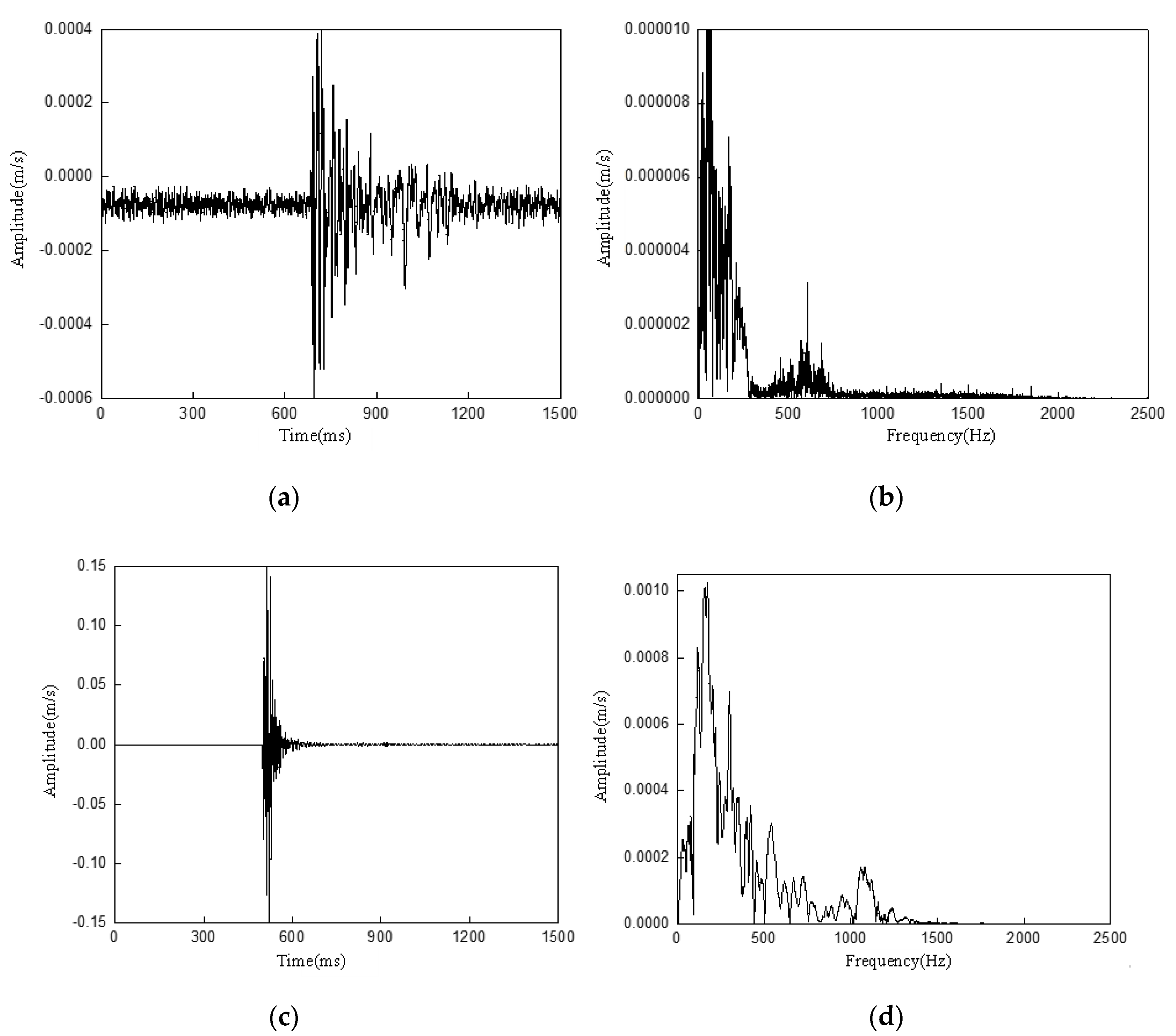
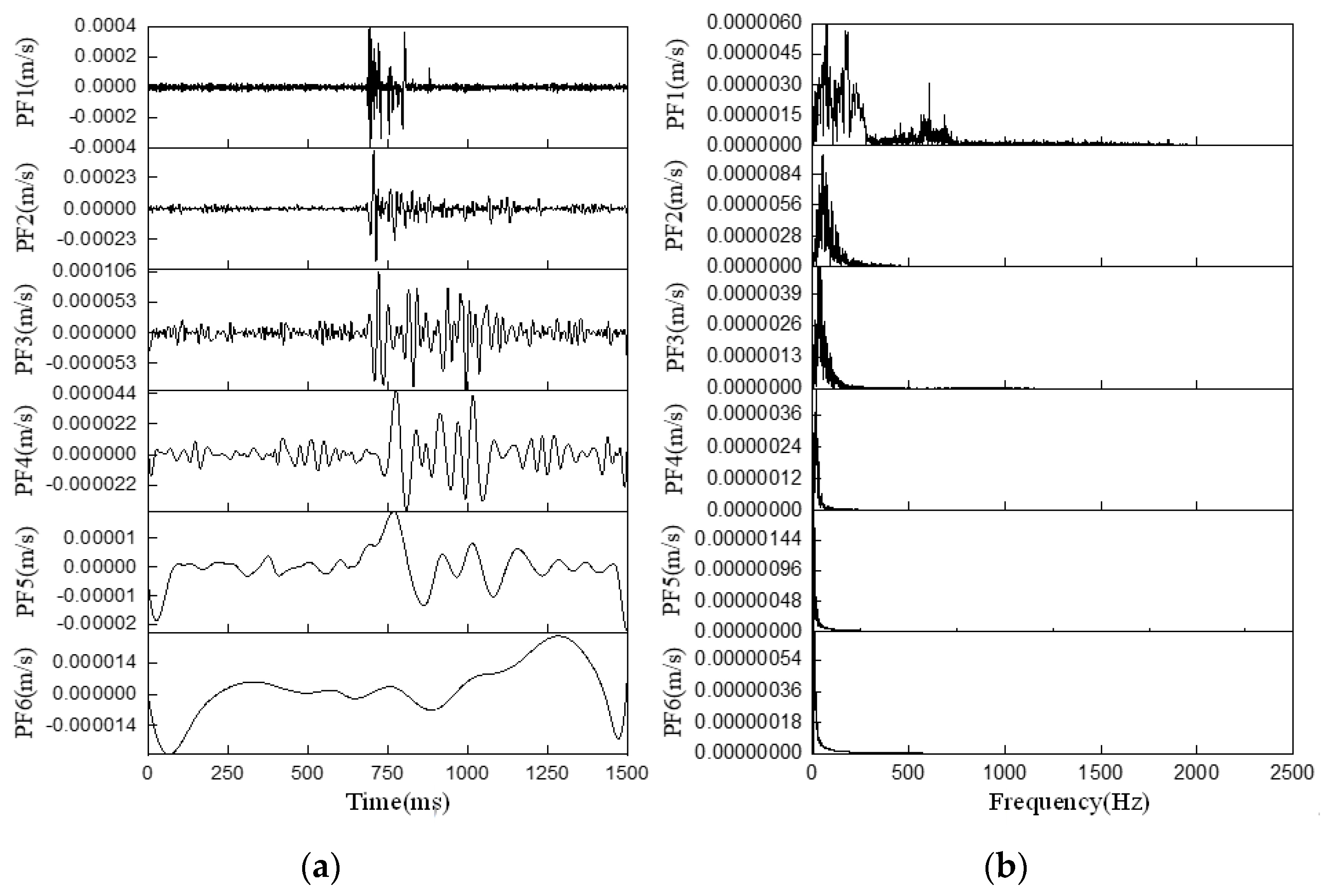
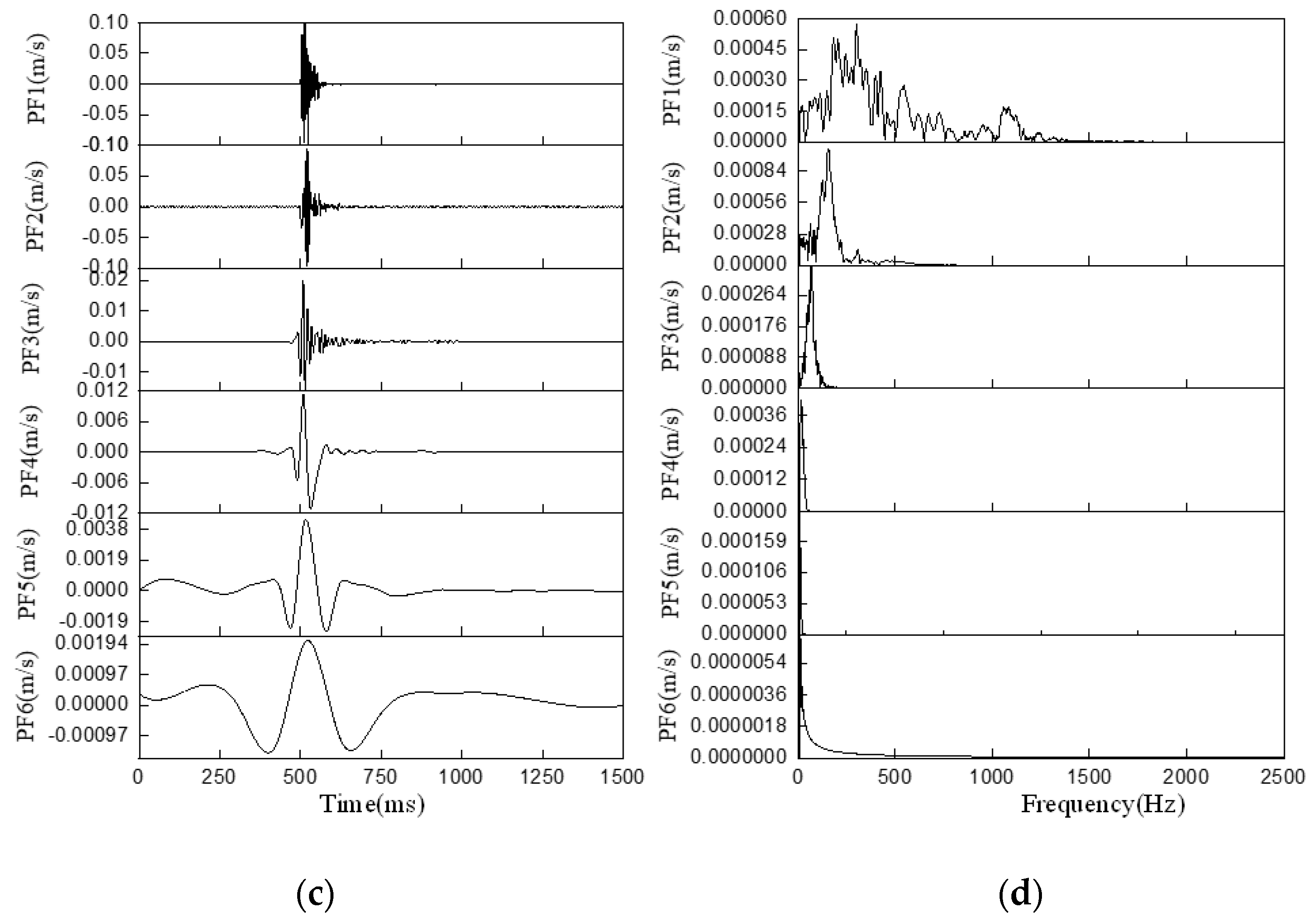
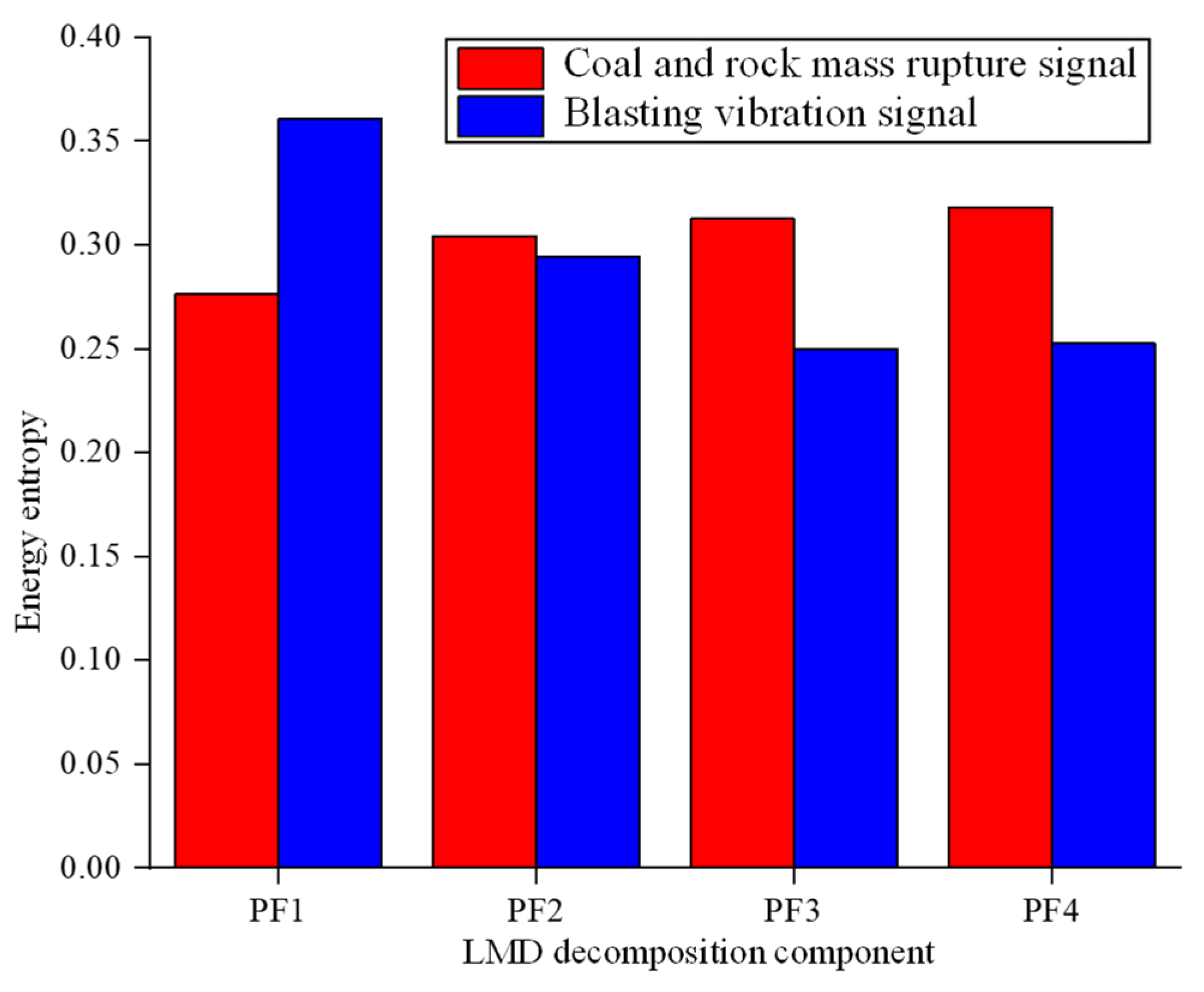
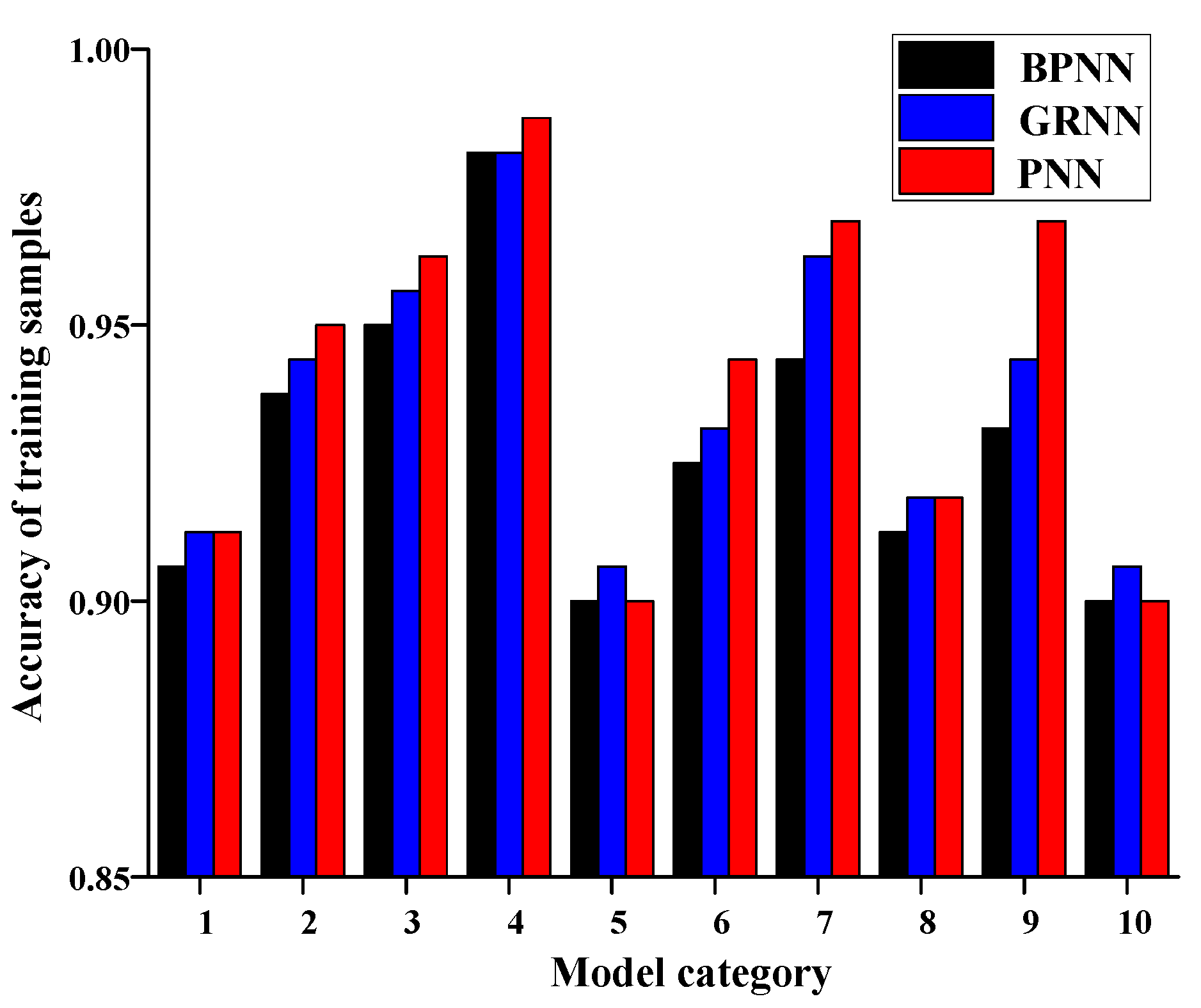
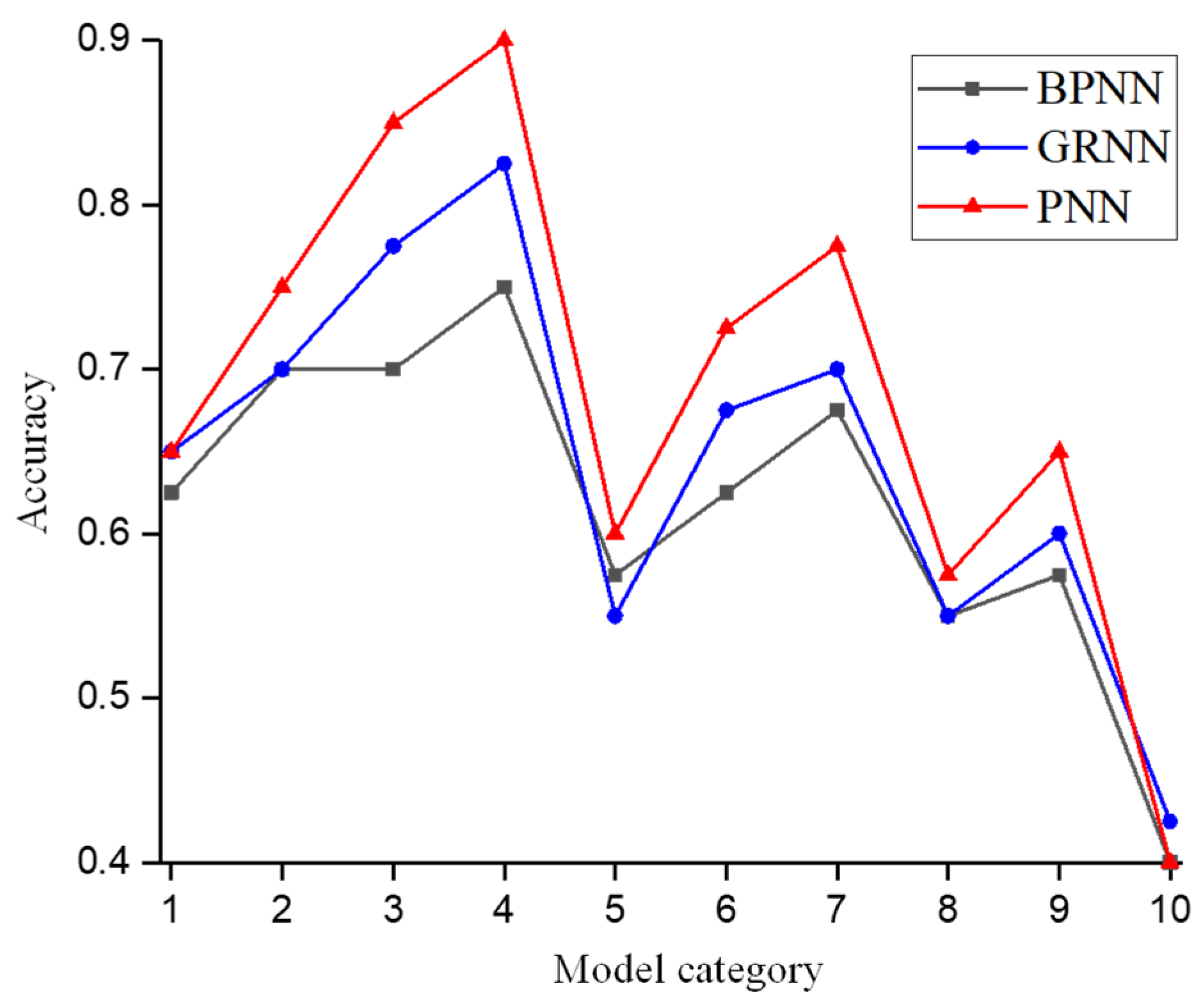


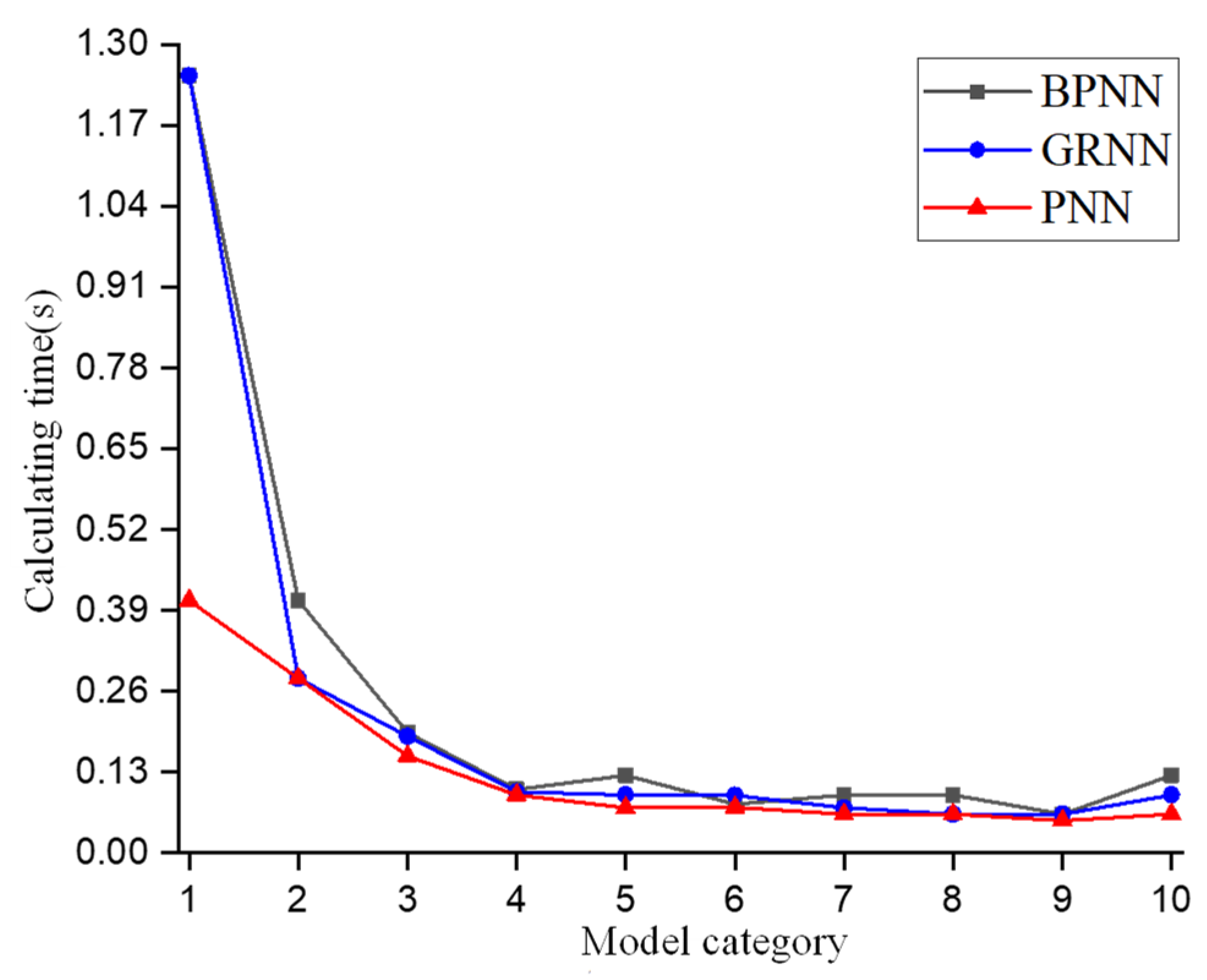
| Signal Type | FM1 | FM2 | FM3 | FM4 | FM5 | FM6 |
|---|---|---|---|---|---|---|
| Rupture signal | 0.667 | 0.684 | 0.305 | 0.137 | 0.002 | 0.001 |
| Blasting signal | 0.689 | 0.761 | 0.151 | 0.062 | 0.011 | 0.001 |
| Classification | Blasting Signal (20 Groups) | Rupture Signal (20 Groups) | Total Result (40 Groups) | |||
|---|---|---|---|---|---|---|
| Exact Number | Accuracy | Exact Number | Accuracy | Exact Number | Accuracy | |
| BPNN | 16 | 80.0% | 14 | 70.0% | 30 | 75% |
| GRNN | 17 | 85.0% | 16 | 80.0% | 33 | 82.5% |
| PNN | 19 | 95.0% | 17 | 85.0% | 36 | 90% |
| Total | 52 | 86.7% | 47 | 78.3% | 99 | 82.5% |
Publisher’s Note: MDPI stays neutral with regard to jurisdictional claims in published maps and institutional affiliations. |
© 2022 by the authors. Licensee MDPI, Basel, Switzerland. This article is an open access article distributed under the terms and conditions of the Creative Commons Attribution (CC BY) license (https://creativecommons.org/licenses/by/4.0/).
Share and Cite
Li, Q.; Li, Y.; He, Q. Mine-Microseismic-Signal Recognition Based on LMD–PNN Method. Appl. Sci. 2022, 12, 5509. https://doi.org/10.3390/app12115509
Li Q, Li Y, He Q. Mine-Microseismic-Signal Recognition Based on LMD–PNN Method. Applied Sciences. 2022; 12(11):5509. https://doi.org/10.3390/app12115509
Chicago/Turabian StyleLi, Qiang, Yingchun Li, and Qingyuan He. 2022. "Mine-Microseismic-Signal Recognition Based on LMD–PNN Method" Applied Sciences 12, no. 11: 5509. https://doi.org/10.3390/app12115509
APA StyleLi, Q., Li, Y., & He, Q. (2022). Mine-Microseismic-Signal Recognition Based on LMD–PNN Method. Applied Sciences, 12(11), 5509. https://doi.org/10.3390/app12115509







